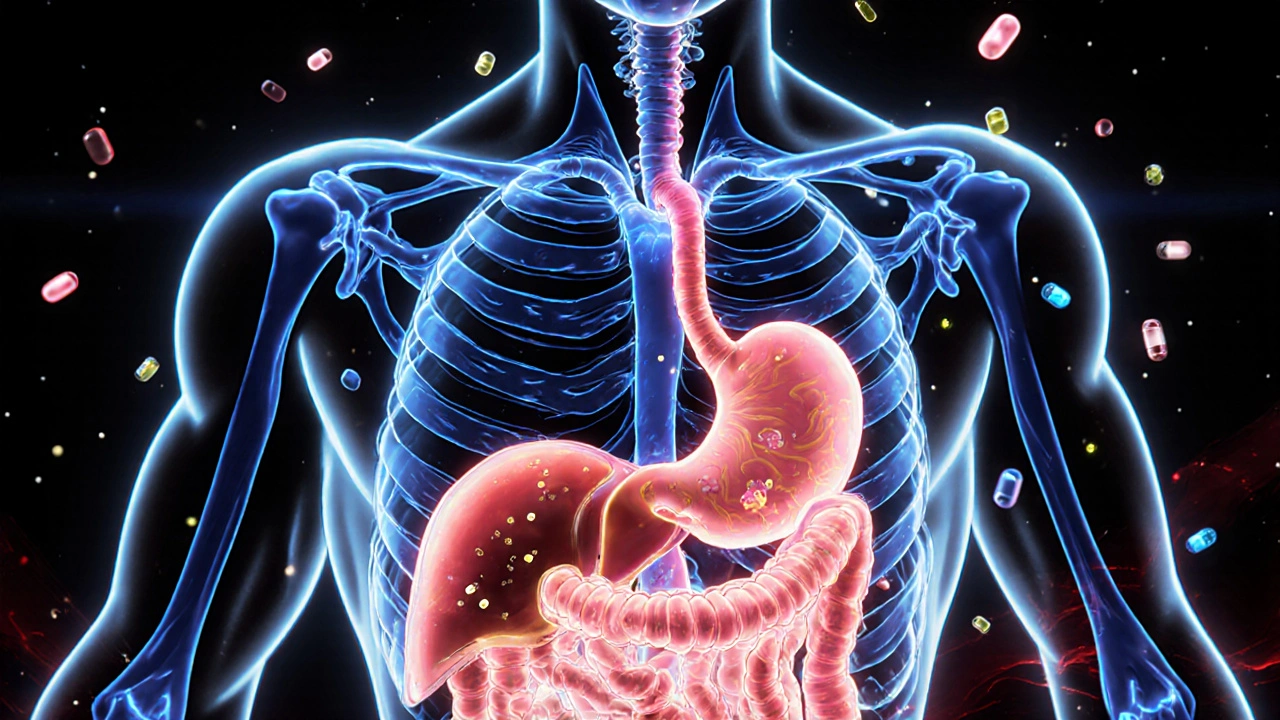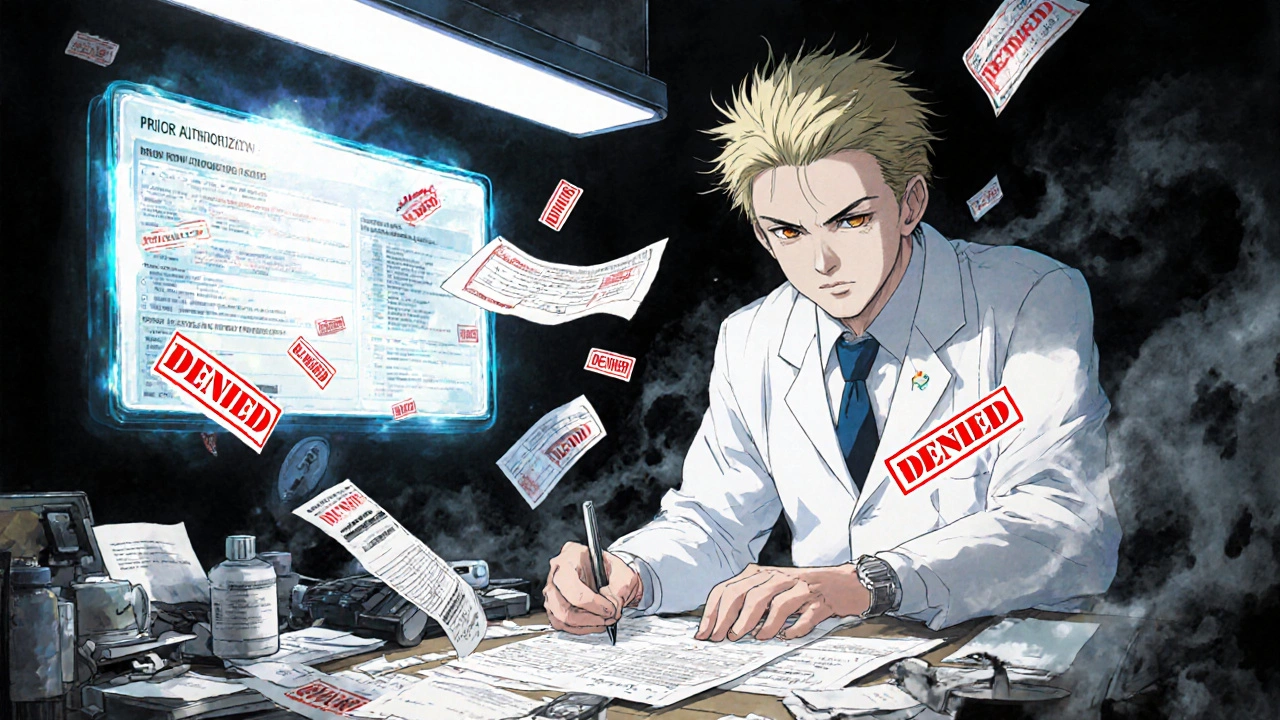Pharmacokinetics and Side Effects: How Your Body Processes Drugs

Kidney Function Dose Calculator
Your kidneys filter waste from your blood. For many drugs, this is the primary way they're removed from your body. As kidney function declines with age or disease, these medications can build up to dangerous levels.
Estimated Kidney Function
Based on your kidney function, your doctor may need to adjust your medication dose. This calculator estimates your creatinine clearance, but always consult your healthcare provider for medical advice.
Ever wonder why a pill that works perfectly for your friend gives you a headache? Or why your grandma needs a lower dose of the same medicine you take? It’s not luck. It’s not magic. It’s pharmacokinetics-the science of how your body moves, changes, and gets rid of drugs. Understanding this process isn’t just for doctors and pharmacists. If you’re taking any medication, knowing how your body handles it can help you avoid dangerous side effects and get the most out of your treatment.
What Happens When You Swallow a Pill?
When you take a drug, whether it’s a pill, injection, or patch, your body doesn’t just leave it alone. It actively works to absorb, distribute, break down, and remove it. This four-step journey is called ADME: Absorption, Distribution, Metabolism, and Excretion. Each step is a checkpoint that determines how much of the drug actually reaches your target and how long it stays around.Let’s start with absorption. If you take a pill, it has to get from your stomach into your bloodstream. But not all of it makes it. For most oral drugs, only 40% to 60% of the dose enters circulation. Why? Because your liver gets first crack at it. This is called first-pass metabolism. The liver breaks down some of the drug before it ever reaches the rest of your body. That’s why some medications, like nitroglycerin, are given under the tongue-bypassing the liver means more of the drug works right away.
How well a drug gets absorbed depends on things like your stomach acid, how fast food moves through your gut, and even your gut bacteria. Some drugs, like digoxin, get blocked by a protein called P-glycoprotein that acts like a bouncer at the intestinal door. If you’re taking something that triggers this protein, your body might absorb less than half of what you swallowed.
Where Does the Drug Go After It Enters Your Blood?
Once in your bloodstream, the drug doesn’t just hang out in your veins. It spreads out-some stays in the blood, some sinks into your muscles, fat, or even your brain. This spread is measured by something called volume of distribution (Vd). A low Vd means the drug mostly stays in your blood. A high Vd means it’s soaking into tissues.Take warfarin, a blood thinner. About 98% of it sticks to proteins in your blood, leaving only 2% active. That tiny fraction is what prevents clots-but it’s also why even small changes in protein levels can make warfarin too strong or too weak. If you get sick, stop eating protein, or start taking another drug that competes for those protein spots, your warfarin levels can spike. That’s when you risk dangerous bleeding.
Some drugs, like antidepressants or painkillers, slip easily into fatty tissues. That’s why they can hang around for days. Your body doesn’t just flush them out quickly. They slowly leak back into your blood, keeping you affected long after you took the last pill.
Your Liver: The Drug Breakdown Factory
The liver is where most drugs get transformed. It uses enzymes-especially a family called Cytochrome P450-to turn fat-soluble drugs into water-soluble ones so your kidneys can flush them out. One enzyme, CYP3A4, handles about half of all medications you’ll ever take. That includes statins, antibiotics, and even some cancer drugs.But here’s the catch: your enzymes aren’t the same as your neighbor’s. Genetics play a huge role. About 3% to 10% of white people have a version of CYP2D6 that barely works. If you’re one of them and take codeine, your body can’t turn it into morphine. You get no pain relief. Meanwhile, someone else with super-active CYP2D6 turns codeine into morphine too fast-risking overdose even at normal doses.
Drugs can also interfere with each other. Take clarithromycin, an antibiotic, and simvastatin, a cholesterol drug. Clarithromycin shuts down CYP3A4. That means simvastatin builds up in your blood. What’s normally a safe dose can suddenly raise your risk of muscle damage from 0.04% to 0.5%. That’s not rare. It’s predictable-and preventable-if someone checks for interactions.

How Your Body Gets Rid of Drugs
Most drugs leave your body through your kidneys. Your kidneys filter your blood, and anything small enough and water-soluble gets flushed out in urine. That’s why kidney function matters so much. Normal kidney clearance is 90 to 120 mL per minute. But in older adults or people with kidney disease, that number can drop below 15. If you keep giving the same dose, the drug piles up. Vancomycin, an antibiotic, is a classic example. In a 78-year-old with reduced kidney function, the same dose that works for a young person can cause permanent kidney damage.Some drugs are also cleared through bile into the gut, then out in stool. And yes, your gut bacteria can break down drugs too-something scientists are only starting to understand. One study found that 15% to 20% of oral drugs are altered by bacteria before they’re even absorbed. That could explain why some people respond differently to the same medicine.
Why Side Effects Aren’t Random
Side effects aren’t just bad luck. They’re often the direct result of pharmacokinetics gone off-track. When drug levels get too high, you get toxicity. Too low, and the drug doesn’t work.Phenytoin, used for seizures, has a narrow window. At 10 mcg/mL, it’s therapeutic. At 20 mcg/mL, 30% of people start having tremors, confusion, and even seizures from the drug itself. That’s not a coincidence. It’s pharmacokinetics. The drug built up because the person’s liver slowed down, or they took another drug that blocked its breakdown.
Diazepam (Valium) is another example. Its main metabolite, desmethyldiazepam, sticks around for up to 100 hours. In young people, it clears fine. In older adults, who have slower liver and kidney function, it builds up. That’s why elderly patients on diazepam are at higher risk of falls and confusion. It’s not the drug being “too strong.” It’s the body not clearing it fast enough.
And then there’s genetics. Warfarin users with certain CYP2C9 variants have a five times higher risk of bleeding on standard doses. That’s why some doctors now test for these genes before prescribing. It’s not experimental. It’s standard in places like the U.S. and Europe for drugs like abacavir and clopidogrel.

Age, Health, and Other Hidden Factors
You’re not a textbook. Your body changes. As you age, your liver processes drugs 30% to 50% slower. Your kidneys clear them 30% to 40% slower. That’s why older adults have three times more adverse drug reactions than younger people. It’s not because they’re “fragile.” It’s because their pharmacokinetics changed.Being overweight? Your fat tissue can soak up fat-soluble drugs, delaying their effect. Dehydrated? Your kidneys can’t filter well. Diabetic? Your liver enzymes might work differently. Even something as simple as eating grapefruit can block CYP3A4 and make your blood pressure or cholesterol meds dangerously strong.
And here’s the kicker: most prescriptions are based on average people. The studies that approved your drug were mostly done on healthy white men aged 18 to 45. But 85% of those study participants represent only 15% of real-world users. Women, older adults, people of color, and those with chronic diseases are underrepresented. That means your dose might be wrong-not because you’re doing something wrong, but because the system wasn’t built for you.
What Can You Do?
You don’t need to become a pharmacologist. But you can ask the right questions:- Is this drug known to interact with anything else I take?
- Could my kidney or liver function affect how this works?
- Am I on any other meds that might slow down how my body clears this one?
- Has my dose been checked since I turned 65 or started having kidney issues?
Ask your pharmacist. They’re trained to spot these issues. Bring a full list of everything you take-including supplements, vitamins, and over-the-counter drugs. Many side effects come from combinations no one thought to check.
Some hospitals now use tools like DoseMeRx, an AI system that calculates your perfect dose based on your age, weight, kidney function, and genetics. It cuts vancomycin dosing errors by 62%. That’s not science fiction. It’s here.
Pharmacokinetics isn’t just a lab concept. It’s the reason your medicine works-or doesn’t. It’s why side effects happen. And it’s the key to safer, smarter treatment. The future of medicine isn’t one-size-fits-all. It’s one-size-fits-you. And that starts with understanding how your body handles drugs.
What does pharmacokinetics mean?
Pharmacokinetics is the study of how your body absorbs, distributes, metabolizes, and excretes a drug. It answers the question: "What does my body do to the medicine?" This is different from pharmacodynamics, which looks at what the drug does to your body.
Why do some people have side effects and others don’t?
Differences in genetics, age, liver and kidney function, diet, and other medications cause variations in how drugs are processed. For example, 3-10% of people have a genetic variant that makes them poor metabolizers of codeine, so they get no pain relief. Others process it too quickly and risk overdose. Even small changes in kidney function can cause drug buildup and toxicity.
Can food affect how my medication works?
Yes. Grapefruit juice blocks liver enzymes that break down many drugs, causing dangerous buildup. High-fat meals can speed up absorption of some drugs, while others need to be taken on an empty stomach. Fiber can bind to medications and reduce absorption. Always check if your drug has food interactions.
How do I know if my dose is too high or too low?
For some drugs like warfarin, phenytoin, or digoxin, blood tests can measure levels. If you’re experiencing side effects or the drug isn’t working, ask your doctor if therapeutic drug monitoring is appropriate. Symptoms like dizziness, nausea, confusion, or unusual bleeding can signal toxicity.
Why do older adults need lower doses?
As we age, liver metabolism slows by 30-50%, and kidney clearance drops by 30-40%. This means drugs stay in the body longer, increasing the risk of buildup and side effects. Even if a dose was safe at 40, it might be dangerous at 75. Age-based dosing adjustments are essential, not optional.
Are genetic tests for drug metabolism worth it?
For certain drugs, yes. Testing for CYP2C19 before taking clopidogrel can prevent stent clots. HLA-B*5701 screening before abacavir prevents life-threatening allergic reactions. These tests are already standard in guidelines. For other drugs, they’re emerging. If you’ve had unexplained side effects or poor response to meds, ask your doctor about pharmacogenetic testing.





